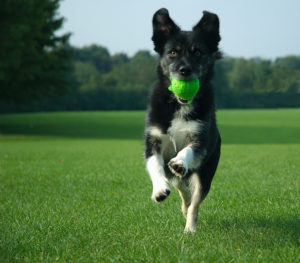It Is Possible To Have A Dog And A Garden
A pet dog is a huge part of many families. And why not? They are loyal and love you know matter how bad a day we had. Many homeowners feel that once they have a dog, there goes the garden. That does not have to be the case.
Start With A Design
The best way to accomplish both goals is to design your garden to meet your dog’s needs as well as your own. It is necessary to design a landscape that will leave room for you dog to be able to romp and race without injuring himself or trampling your flowers―well, most of the time, anyway. Owning a dog also means giving up perfectionism and learning forgiveness.
Each breed of dog has different needs and a different personality. Understanding this will allow you to create a design that best fits the individual. The more attention that is paid to this, the happier the dog and the happier the owner. An area to run, border control, a cool and soft place to lay, sensible plants and a marking post are all good features to consider.
Consider The Plants
Most plants are safe for pets but avoid spiny and thorny plants as they can cause eye injuries. Visit www.aspca.org/toxicplants for a complete list of pet poisonous plants.
Many wild mushrooms produce afla-toxins, which can be fatal if ingested by dogs; if mushrooms appear, dig and dispose of them immediately. Your compost pile should be off-limits for the same reason. Weeds can be dangerous, especially foxtail grasses with barbed seed heads, which dogs can accidentally inhale with serious consequences.
Related Posts:
How To Design Your Backyard Landscape Paradise
Outdoor Kitchen, Fire Pit & Patio in North Potomac, MD
Remember, Allentuck Landscaping Co. is always here to help you design, install, construct and maintain you lawn and landscape. Give us a call!
Allentuck Landscaping Co. is Your Residential Landscape Company
Phone: 301-5-515-1900 Email: info@allentucklandscaping.com
At Allentuck Landscaping Co., our mission is to create beautiful environments for people to enjoy. We see landscaping as a way to improve people’s lives.
The Allentuck Landscaping Co. team has been delighting homeowners in Maryland, Washington DC and Northern Virginia for over 28 years with our turnkey approach to landscape design, installation, construction and maintenance. Most companies try to serve many types of customers at the same time; homeowners, shopping centers, office buildings and the list goes on. At Allentuck Landscaping Co., we focus on one customer, you, the homeowner. We have a singular focus on bringing you the best landscape practices, the best customer service, and the best value for your home.
Services Provide – Master Landscape Plans, Complete Maintenance Programs, Plantings, Patios, Walkways, Retaining Walls, Water Features, Outdoor Lighting, Outdoor Kitchens, Trellises & Pergolas, Irrigation Systems, Drainage Solutions, Grading & Sodding. Fire Pits & Fire Places, Spring Clean Ups, Decks, Fences
Areas Served – Chevy Chase, Bethesda, Potomac, Rockville, North Potomac, Darnestown, Gaithersburg, Germantown, Boyds, Clarksburg, Ijamsville, Urbana, Frederick and Washington DC.

